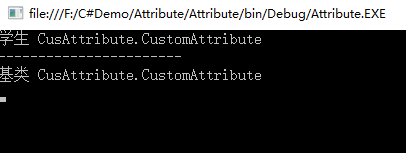在项目中经常可以看到在类属性上面有一个[]的东西,今天讲的东西就是它,它英文名是Attribute,中文名是特性。
一、什么是特性?
首先,我们肯定Attribute是一个类,下面是msdn文档对它的描述:
公共语言运行时允许你添加类似关键字的描述声明,叫做attributes, 它对程序中的元素进行标注,如类型、字段、方法和属性等。Attributes和Microsoft .NET Framework文件的元数据保存在一起,可以用来向运行时描述你的代码,或者在程序运行的时候影响应用程序的行为。
在.NET中,Attribute被用来处理多种问题,比如序列化、程序的安全特征、防止即时编译器对程序代码进行优化从而代码容易调试等等。下面,我们先来看几个在.NET中标准的属性的使用,稍后我们再回过头来讨论Attribute这个类本身。(文中的代码使用C#编写,但同样适用所有基于.NET的所有语言)。上面的解释说实话这是我复制粘贴的。
二、自定义特性
除了C#中系统自带的特性外我们可以自己定义一些特性。所有自定义的Attribute必须从Attribute类派生,命名也是要以Attribute结尾,在使用的时候可以省略Attribute。
using System; using System.Collections.Generic; using System.Linq; using System.Text; using System.Threading.Tasks; namespace CusAttribute { [AttributeUsage(AttributeTargets.Class,AllowMultiple =true,Inherited =false)] public class CustomAttribute:System.Attribute { public string CustormDescription { get; } public CustomAttribute(string des) { CustormDescription = des; } } }
在上面的代码中定义了一个CustomAttribute特性,继承自Attribute类,主要功能是为类添加描述信息。不过在类声明的上一行有一个中括号[AttributeUsage(AttributeTargets.Class,AllowMultiple =true,Inherited =false)] ,这里面的AttributeUsage又是什么玩意呢?我们可以转到定义来看一下:

看定义可以看到,AttributeUsage其实也是继承自Attribute,也是一个特性。那来说下这个类里面的3个属性validOn、AllowMultiple、Inherited.
1.validOn:可以看到它是AttributeTargets类型,而AttributeTargets转到定义可以看到是一个枚举类型。指明Attribute 可以被施加的元素的类型。
2.AllowMultiple:它是一个布尔值。表示是否可以对一个程序元素施加多个Attribute。
3.Inherited:它也是一个布尔值,表示是否施加的Attribute 可以被派生类继承或者重载
使用下面的代码一步一步验证上面的3个属性。
我们定义了一个Person基类,定义了Student类继承自Person类。
1.AllowMultiple
将上面的特性设置为[AttributeUsage(AttributeTargets.Class,AllowMultiple =true,Inherited =false)]时
using System; using System.Collections.Generic; using System.Linq; using System.Text; using System.Threading.Tasks; namespace CusAttribute { [CustomAttribute("人")] [Custom("基类")] public class Person { public string Name { get; set; } public int Age { get; set; } } }
上面使用两次特性,也是没有报错是可以的,但是如果AllowMultiple设为false,编译时就会报错.

2.Inherited
先把Student、Person类也贴出来
using System; using System.Collections.Generic; using System.Linq; using System.Text; using System.Threading.Tasks; namespace CusAttribute { [CustomAttribute("学生")] public class Student:Person { public string StudentId { get; set; } } }
using System; using System.Collections.Generic; using System.Linq; using System.Text; using System.Threading.Tasks; namespace CusAttribute { //[CustomAttribute("人")] [Custom("基类")] public class Person { public string Name { get; set; } public int Age { get; set; } } }
using System; using System.Collections.Generic; using System.Linq; using System.Text; using System.Threading.Tasks; namespace CusAttribute { class Program { static void Main(string[] args) { System.Reflection.MemberInfo info = typeof(Student); object[] attributes = info.GetCustomAttributes(true); for (int i = 0; i < attributes.Length; i++){ CustomAttribute attr = (CustomAttribute)attributes[i]; System.Console.WriteLine("{0} {1}", attr.CustormDescription, attributes[i]); } Console.WriteLine("-----------------------"); info = typeof(Person); attributes = info.GetCustomAttributes(true); for (int i = 0; i < attributes.Length; i++) { CustomAttribute attr = (CustomAttribute)attributes[i]; System.Console.WriteLine("{0} {1}",attr.CustormDescription,attributes[i]); } Console.ReadLine(); } } }
在main方法中我们Student和Person类中的特性并输出,通过反射,至于反射以后会有提到
和AllowMultiple一起有4种可能性.
AllowMultiple:false Inherited:true

AllowMultiple:false Inherited:false

AllowMultiple:true Inherited:false

AllowMultiple:true Inherited:true

对于Inherited:false时就不说了,不能被派生类继承,当Inherited:true时,AllowMultiple:true的话派生类不会覆盖父类的特性,AllowMultiple:false的话派生类会覆盖父类的特性。
3.validOn
这个主要是一个枚举。可以看下枚举都有什么.也就是说可以将特性应用到下面的枚举类型中。
// // 摘要: // 指定可以对它们应用特性的应用程序元素。 [ComVisible(true)] [Flags] public enum AttributeTargets { // // 摘要: // 可以对程序集应用属性。 Assembly = 1, // // 摘要: // 可以对模块应用属性。 Module = 2, // // 摘要: // 可以对类应用属性。 Class = 4, // // 摘要: // 可以对结构应用属性,即值类型。 Struct = 8, // // 摘要: // 可以对枚举应用属性。 Enum = 16, // // 摘要: // 可以对构造函数应用属性。 Constructor = 32, // // 摘要: // 可以对方法应用属性。 Method = 64, // // 摘要: // 可以对属性 (Property) 应用属性 (Attribute)。 Property = 128, // // 摘要: // 可以对字段应用属性。 Field = 256, // // 摘要: // 可以对事件应用属性。 Event = 512, // // 摘要: // 可以对接口应用属性。 Interface = 1024, // // 摘要: // 可以对参数应用属性。 Parameter = 2048, // // 摘要: // 可以对委托应用属性。 Delegate = 4096, // // 摘要: // 可以对返回值应用属性。 ReturnValue = 8192, // // 摘要: // 可以对泛型参数应用属性。 GenericParameter = 16384, // // 摘要: // 可以对任何应用程序元素应用属性。 All = 32767 }